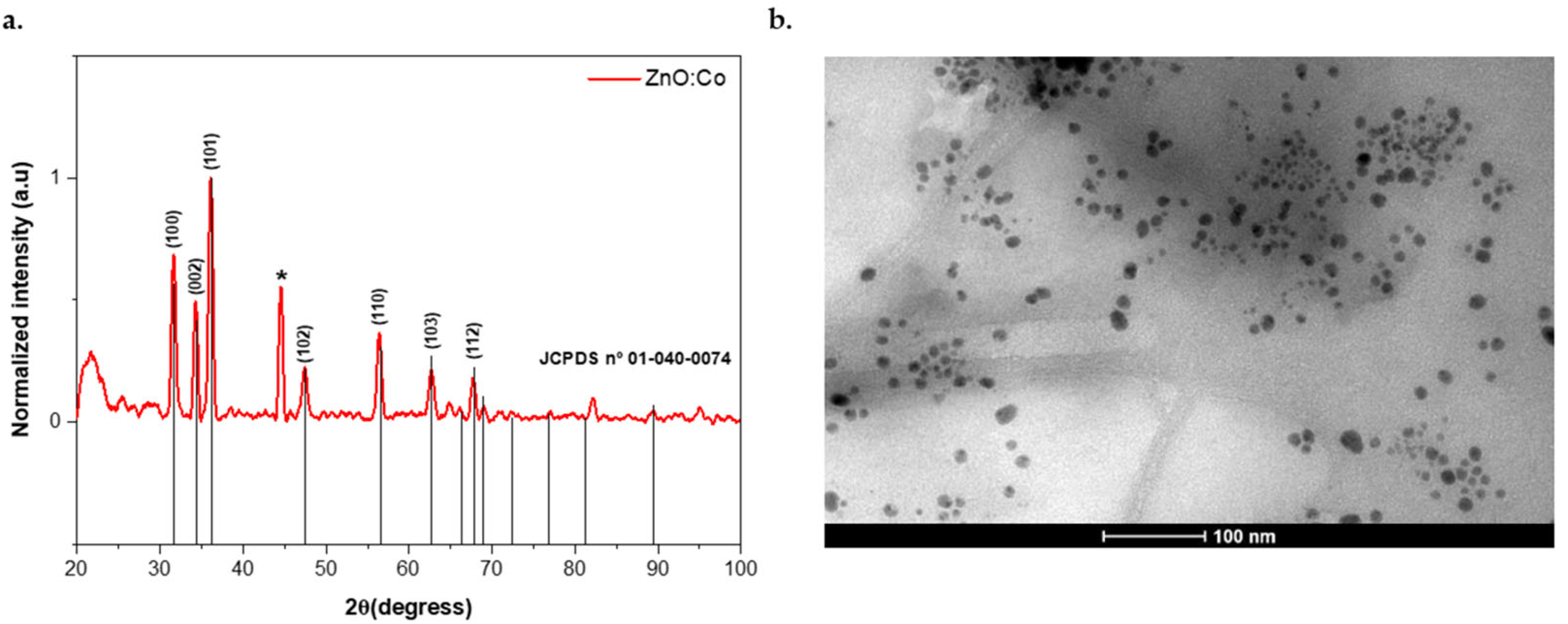Improving the Mechanical Properties of Mortars by Adding Metal-Doped Zinc Oxide Nanoparticles †
Abstract
:1. Introduction
2. Materials and Methods
2.1. Synthesis and Characterization of ZnO:Co Nanoparticles
2.2. Mortar Preparation and Characterization
3. Results and Discussion
3.1. Synthesis and Characterization of ZnO:Co NPs
3.2. Mortar Preparation and Characterization
4. Conclusions
Author Contributions
Funding
Institutional Review Board Statement
Informed Consent Statement
Data Availability Statement
Acknowledgments
Conflicts of Interest
References
- Han, B.; Ding, S.; Wang, J.; Ou, J. Nano-Engineered Cementitious Composites; Nano-BN-Engineered Cementitious Composites; Springer: Singapore, 2019; pp. 639–664. [Google Scholar]
- Islam, B. Petroleum sludge, its treatment and disposal: A review. Int. J. Chem. Sci. 2015, 13, 1584–1602. [Google Scholar]
- Babor, D.T.; Judele, L. Environmental Impact of Concrete; Universitatea Tehnică “Gheorghe Asachi”: Iasi, Romania, 2009. [Google Scholar]
- Malhotra, V.M.; Mehta, P.K. Pozzolanic and Cementitious Materials, 1st ed.; CRC Press: Boca Raton, FL, USA; Taylor & Francis: London, UK, 1996. [Google Scholar]
- Hanus, M.J.; Harris, A.T. Nanotechnology innovations for the construction industry. Prog. Mater. Sci. 2013, 58, 1056–1102. [Google Scholar] [CrossRef]
- Loh, K.; Gaylarde, C.C.; Shirakawa, M.A. Photocatalytic activity of ZnO and TiO2 ‘nanoparticles’ for use in cement mixes. Constr. Build. Mater. 2018, 167, 853–859. [Google Scholar] [CrossRef]
- Silva, T.G.; Moura, I.M.R.; Filho, P.E.C.; Pereira, M.I.A.; Filho, C.A.A.; Pereira, G.; Pereira, G.A.L.; Fontes, A.; Santos, B.S. ZnSe:Mn aqueous colloidal quantum dots for optical and biomedical applications. Phys. Status Solidi C 2016, 13, 530–533. [Google Scholar] [CrossRef]
- Gandhi, V.; Ganesan, R.; Syedahamed, H.H.A.; Thaiyan, M. Effect of Cobalt Doping on Structural, Optical, and Magnetic Properties of ZnO Nanoparticles Synthesized by Coprecipitation Method. J. Phys. Chem. C 2014, 118, 9717–9725. [Google Scholar] [CrossRef]
- Mukhtar, M.; Munisa, L.; Saleh, R. Co-Precipitation Synthesis and Characterization of Nanocrystalline Zinc Oxide Particles Doped with Cu2+ Ions. Mater. Sci. Appl. 2012, 3, 543–551. [Google Scholar] [CrossRef]
- Rabiei, M.; Palevicius, A.; Monshi, A.; Nasiri, S.; Vilkauskas, A.; Janusas, G. Comparing Methods for Calculating Nano Crystal Size of Natural Hydroxyapatite Using X-ray Diffraction. Nanomaterials 2020, 10, 1627. [Google Scholar] [CrossRef] [PubMed]
- Reddy, A.J.; Kokila, M.; Nagabhushana, H.; Chakradhar, R.; Shivakumara, C.; Rao, J.; Nagabhushana, B. Structural, optical and EPR studies on ZnO:Cu nanopowders prepared via low temperature solution combustion synthesis. J. Alloys Compd. 2011, 509, 5349–5355. [Google Scholar] [CrossRef]
- Sato, T.; Diallo, F. Seeding Effect of Nano-CaCO3 on the Hydration of Tricalcium Silicate. J. Transp. Res. Board 2010, 2141, 61–67. [Google Scholar] [CrossRef]
- Gaitero, J.; Campillo, I.; Guerrero, A. Reduction of the calcium leaching rate of cement paste by addition of silica nanoparticles. Cem. Concr. Res. 2008, 38, 1112–1118. [Google Scholar] [CrossRef]


| Reflections | Peaks Position (2θ) | Size (nm) |
|---|---|---|
| (100) | 31.63 | 14.36 |
| (002) | 34.28 | 16.38 |
| (101) | 36.09 | 14.44 |
| (102) | 47.41 | 13.85 |
| (110) | 56.40 | 15.80 |
| (103) | 62.69 | 14.94 |
| (112) | 67.73 | 19.03 |
Disclaimer/Publisher’s Note: The statements, opinions and data contained in all publications are solely those of the individual author(s) and contributor(s) and not of MDPI and/or the editor(s). MDPI and/or the editor(s) disclaim responsibility for any injury to people or property resulting from any ideas, methods, instructions or products referred to in the content. |
© 2023 by the authors. Licensee MDPI, Basel, Switzerland. This article is an open access article distributed under the terms and conditions of the Creative Commons Attribution (CC BY) license (https://creativecommons.org/licenses/by/4.0/).
Share and Cite
Lima, M.; Gonçalves, Í.M.; Pereira, G.; Pereira, G.A.L. Improving the Mechanical Properties of Mortars by Adding Metal-Doped Zinc Oxide Nanoparticles. Eng. Proc. 2023, 56, 331. https://doi.org/10.3390/ASEC2023-16520
Lima M, Gonçalves ÍM, Pereira G, Pereira GAL. Improving the Mechanical Properties of Mortars by Adding Metal-Doped Zinc Oxide Nanoparticles. Engineering Proceedings. 2023; 56(1):331. https://doi.org/10.3390/ASEC2023-16520
Chicago/Turabian StyleLima, Max, Ítalo M. Gonçalves, Goreti Pereira, and Giovannia A. L. Pereira. 2023. "Improving the Mechanical Properties of Mortars by Adding Metal-Doped Zinc Oxide Nanoparticles" Engineering Proceedings 56, no. 1: 331. https://doi.org/10.3390/ASEC2023-16520







